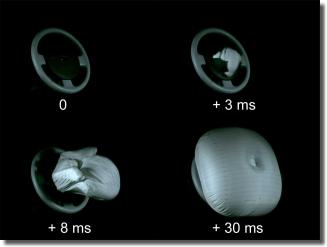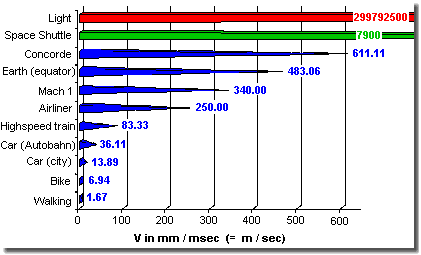Buyer's guide for high-speed cameras
Usage profile

Airbag: already inflated in 30 milliseconds
Easy, one just buys a camera with x million frames per
second and it's a done deal...
Well, but each user has different requirements. It is not only a
matter of costs, it is also a matter of equipment (e.g.
illumination), experience, experimental set-up and so on. There is
a costly trade off between resolution, frame rate and duration of
recording.
The figure on the right shows as example how an
airbag is pumped up within 30 milliseconds. The human eye-shut
reflex, however, needs about 200 to 250 milliseconds.
So it definitely makes no sense to shoot human movement with much
more than 1 000 frames/sec (or even 100 000 frames/sec).
And even a car traveling with 50 km/h (about 31 mph)
moves from frame to frame less as wide as a finger. The impression
of dynamic is completely lost and you will fall asleep when
watching replay.
Or to say it with Douglas R. Hofstadter's Zeno:
»Movement
unexists
« (from Gödel, Escher, Bach: an
Eternal Golden Braid).
Frame rate does not beat everything
Evident, it makes no sense to shoot some ten frames in ultra short time of a process that lasts a second. You will not capture the complete process and the resolution may be too low to visualize structural details. Additionally a too extreme slow-motion will turn the movement study in a boring thing, because the impression of movement is lost. So many of the sequences shown in wildlife movies are shot (or replayed in slow motion, resp.) at a maximum of some hundred frames/sec, even if the speaker tells you cameras with some thousand frames/sec were used. (Of course, here the need for illumination is of certain importance.)

Some selected velocities in comparison
The figure on the left should give you some
insight what happens in a microsecond or what is behind the unit
meter per second.
1 km/h = 3.6 m/s; 1 m/s = 0.2778 km/h; Mach 1
= speed of sound (in air at sea level) (1 meter = 39.370 inches =
3.281 feet = 1.094 yards)
And if slowing down this ultra-fast high-speed camera? Well,
why purchasing an expensive camera with features you will never
use, or which shows its limitations somewhere else just due to its
speed, e.g. with resolution, when there are available cameras much
more suitable for your application? 1 million frames per second or
more are not for free.
Then, however, if one has not really extraordinary demands and
is not too modest concerning performance figures it would not be
impossible to find a standard one fits all device. In clear numbers
(because I'm often asked): for
€/$ 20 000.- ± 5 000.- one
gets a general purpose pro system with about one megapixel resolution
at 1 000 frames/sec inclusive equipment (notebook incl.
software, lenses, spotlight, tripod) and is ready for a wide spread
variety of applications. (When you have acquired a taste fort it
with your smartphone. ;-)
How to get started? - So much has to be taken into account!
Exactly, that's all right so far. In contrast, however,
to a couple of years ago a lot of vendors bustle in the high-speed
camera market, or what they want to sell you for that.
Why not just turn the tables and use the demands of the
application as guidance only? The most expensive, the fastest or the
camera system with the highest pixel count is not necessarily the
best fitting one. Often it is exclusively designed for special
applications and needs adequate accessories (illumination, control
devices, equipment ...) and user know-how.
These pages here should just bring a little light in the darkness,
should show relationships and should explain basic characteristics
- thus should offer some kind of a small buyer's guide for real
high-speed cameras. Thus just a small educational lesson about
speed, frame rate, resolution, illumination, image quality and
data.
| Applications and performances | Consumer electronic | (Industrial) image processing | (Biologic) motion analysis | Research and development | Movie and broadcast |
|---|---|---|---|---|---|
| Resolution | HD (1280x720) and reduction steps | also line sensors; VGA (640x480) to HD (1280x720) | VGA (640x480) to over HD (1280x1024) | below VGA (640x480) over HD (1280x1024) to 4k | (Full) HD to over 4k |
| Frame rate | ~ 120 frames/sec (to 1 000 frames/sec; resolution reduction!) | to 500 frames/sec | 250 to 600 frames/sec | 1000 to over 1 million frames/sec | to ca. 500 frames/sec |
| Sensor manufacturers | Multimedia OEMs | Multimedia OEMs | Electronic OEMs | Internal/external development | Electronic OEMs, internal/external development |
| Camera manufacturers | Multimedia OEMs | Multimedia OEMs, electronic OEMs | System houses | Special equipment manufacturers | Special equipment manufacturers |
| Integration equipment | - | Resale | Resale | In-house production | Resale, in-house production |
| Prices | ~ €/$ 500.- to 1 000.- | ~€/$ 500.- to 5 000.- | ~ €/$ 3 500.- to 25 000.- | ~ €/$ 15 000.- to >100 000.- | ~ €/$ 50 000.- to >100 000.- |
Performance and application cases of high-speed cameras in
overview (OEM: original equipment manufacturer).
The enormous price margin as shown in the table above is due to
on first hand dealing with large-scale manufactured consumer
products or standard image processing with usual data transmission
rates, while on the second hand dealing with high-grade scientific
measurement devices with special techniques, which are partly
individually designed and built by scientists and engineers.
Already since about the year 2000 the wheat from the chaff is
still separated at 1 000 frames/sec with HD resolution.
A ten steps checklist for selecting one's own high-speed camera
-
Which temporal resolution is necessary - vroom, whoosh or whizz? The speed of the object in the image plane and the desired resolution in time, resp. provide clues for the necessary frame and shutter rates: how many photos per second are necessary? How much movement during time of exposure and especially between the frames is tolerable?
Some proposed or typical frame rates (frames per second, fps): human movement analysis and special effects about 100 to 250 fps, very fast sports and industrial adjustment about 500 to 1 000 fps, car crash test about 1 000 to 3 000 fps, air-bag tests about 3 000 to 5 000 fps, explosions, cracks, gunfire and rockets in flight up to about 10 000 fps, lightning flashes, discharge and rifle bullets about 10 000 to 100 000 fps, shells and penetration 100 000 to 500 000 fps, chemical and physical reaction research about 100 000 to 1 000 000 fps and above. -
Which spatial resolution is necessary - how big is the mouse on the stadium grass field? The spatial resolution and the size of the scene affect the lens selection (field of view) and only then the sensor resolution (pixel count). Take notice of the possibly correlation between resolution and frame rate. Expensive steps in technology are combined with sensor resolution.
Some proposed pixel resolutions: industrial adjustment and gait analysis about 512 x 512 or 640 x 480 (VGA, PAL, NTSC) and less, automotive about 1000 x 1000, special effects 1280 x 720 (HDTV) and Full HD 1920 x 1080 (16:9) or better, up to Digital Cinema resolution 2048 x 1080 and above (3D).
Even low resolutions, e.g. 256 x 256 and just below, will be able to provide results of sufficient quality for industrial applications, if real black-and-white cameras will be used. Just have a look on the example sequences shown in [SloMo Clips]. A high resolution will get interesting, if it enables covering the scene with less cameras. -
What memory is required - clip or motion picture? The recording time is a severe cost driving factor. Using intelligent trigger modes leads to a reduction of efforts - according to comedian Otto Waalkes »
The shorter the ssst, the faster the bang!
« In most cases a very few seconds are enough. Not always a big long time recorder with hours of capacity or an expensive technology monster with x-millions frames per second is necessary. -
What data management is planned - archive or serial take? Saving, postprocessing and a requirement for image processing, resp., rise demands for technology, image quality (HDTV, movie?), access (download times!) and storage (memory card, LAN + RAID, Thunderbolt, ...).
Just saving (downloading from the camera memory) alone can be at first sight astonishing time consuming or turn expensive due to the high performance interfaces and media. -
Which illumination is available - bats roundabout midnight? Light is a precious good, because time of exposure often is short. For e.g. 1 000 frames/sec mean that there is not more than 1/1 000 second time of exposure for each single frame - if ever.
Especially for outdoor applications (depth of view, clouds!) and ballistic shots (reduced time of exposure by a shutter in order to reduce motion blur) light sensitivity is an important criterion. True monocolor could be an option. -
Extras - it is a bit over, is that ok? Options (improved shock resistance, extended temperature range ...) and equipment (clock dividing devices for synchronizing, special lighting ...) can considerably push the price. With a high-speed photo camera or smartphone out of the consumer sector, however, one will not have much fun in harsh industrial environment.
-
Connectivity - am I in? Do not forget to check integration in your environment and systems (PLC and IT connections), control software (adequate, stable, easy to use?) and special equipment (automatic special lenses, control devices ...).
Somewhere the (suitable!) trigger signal and possibly other control signals have to come from and possibly generated control signals (strobe out = exposure active, all armed = ready for shot, ...) and image data have to be sent to somewhere, too. -
Hand made - with love? Out of practical experience: have an eye on adequate and suitable (robust) housing, connectors and cables. Just imagine - how often a RJ45 patch cable can be plugged or unplugged by an unskilled hand. And how many mating cycles a consumer electronic socket can endure. Also swiping in any situation, e.g. with oily fingers, is no good deal for a screen.
-
Sustainability - fire and forget? Check whether the equipment is modular concerning upgrade options, exchange, service and maintenance and repair. The technology and product cycles, however, fortunately are not as short as in computer business. There might be the chance to give back the appliance in exchange with a more present model.
-
Short on money - dire strait? Try to get a demo and perhaps think about rental service. This can make the start easier, reduces costs and provides experience. Especially concerning tricky shooting setups. In order to reduce costs also ask a manufacturer for rental, used and demo equipment. Possibly better than creating it on your own or buying it as used anywhere.
Extend the [TOUR] to some additional technical sensor info, tips and tricks for shooting.
